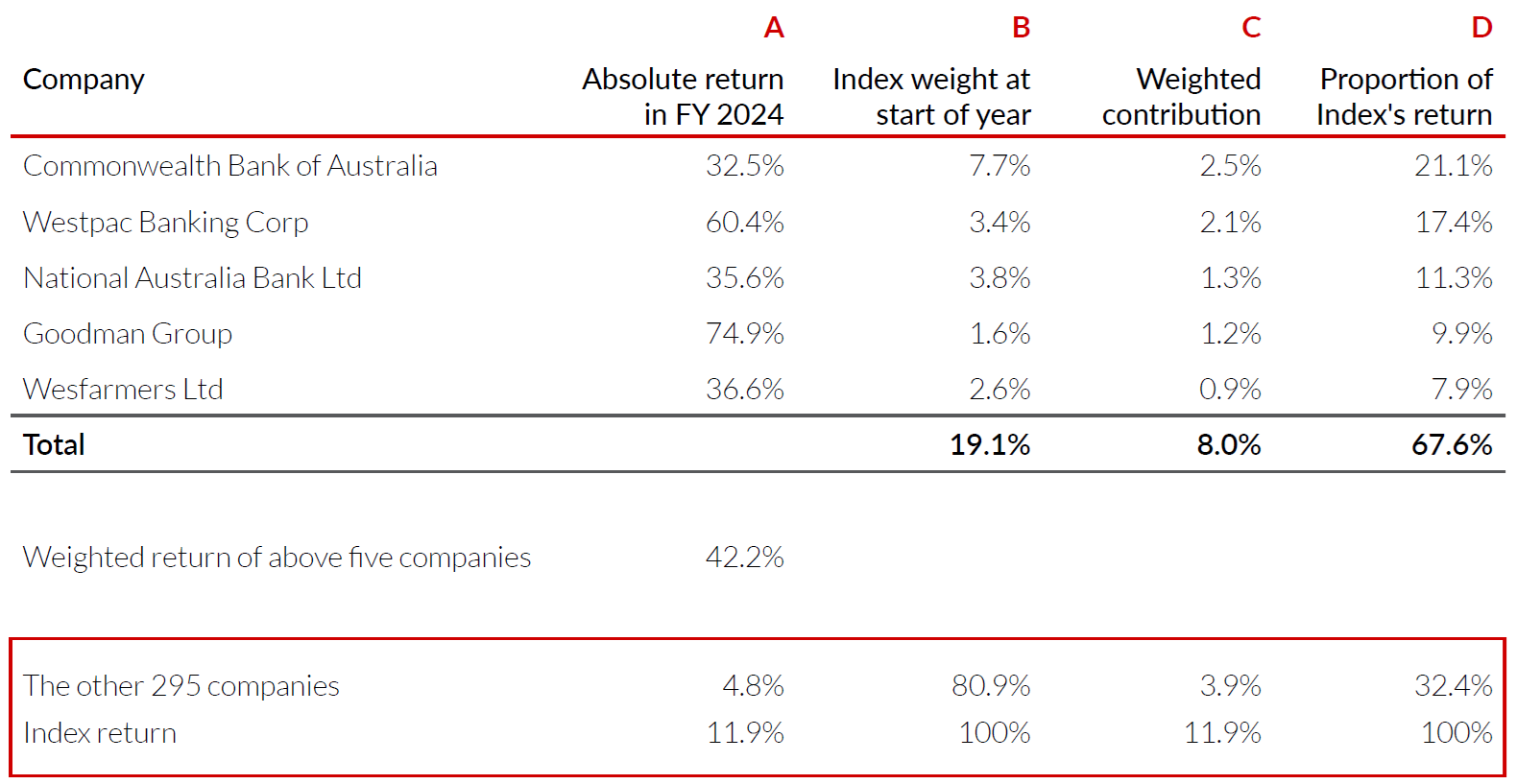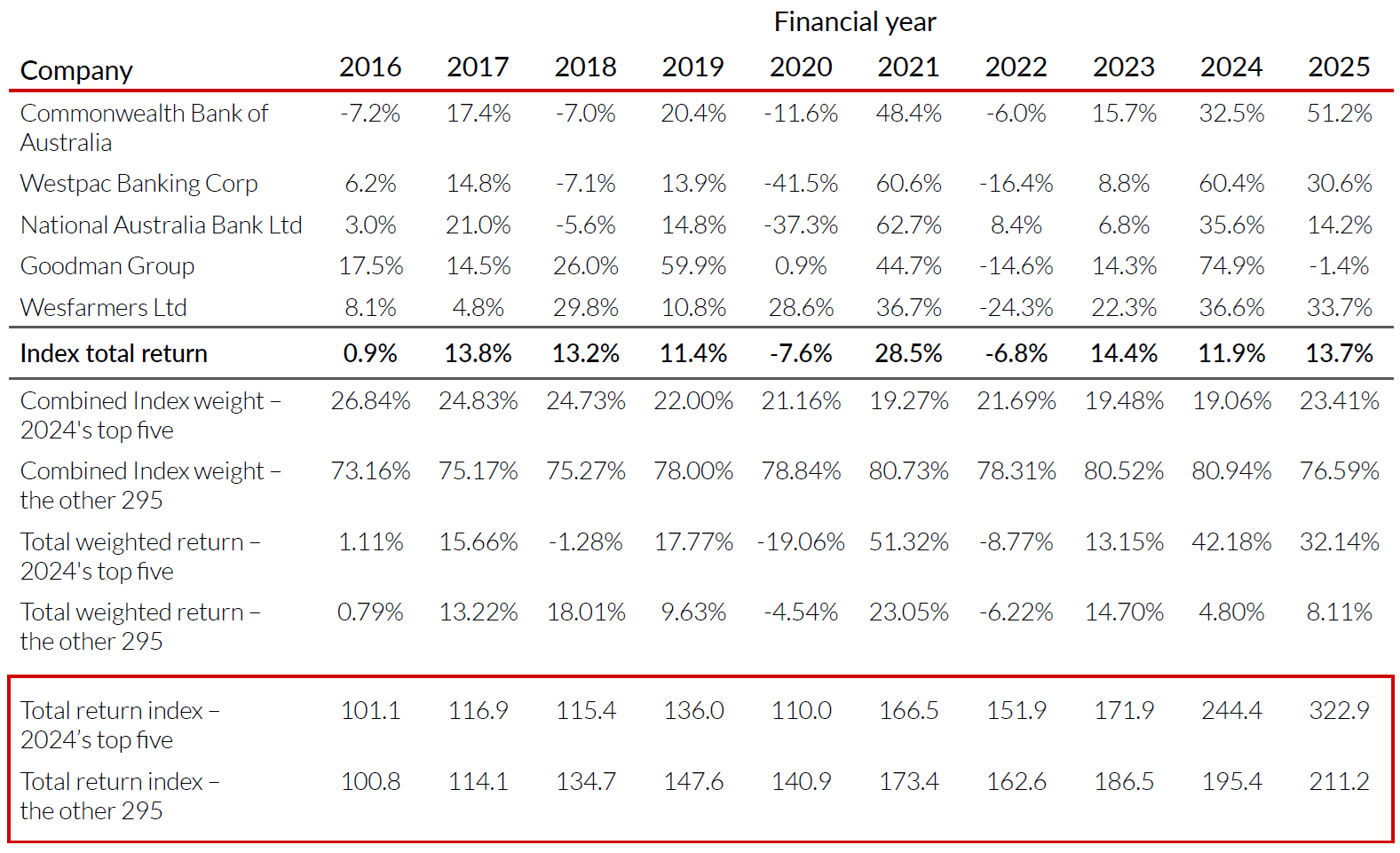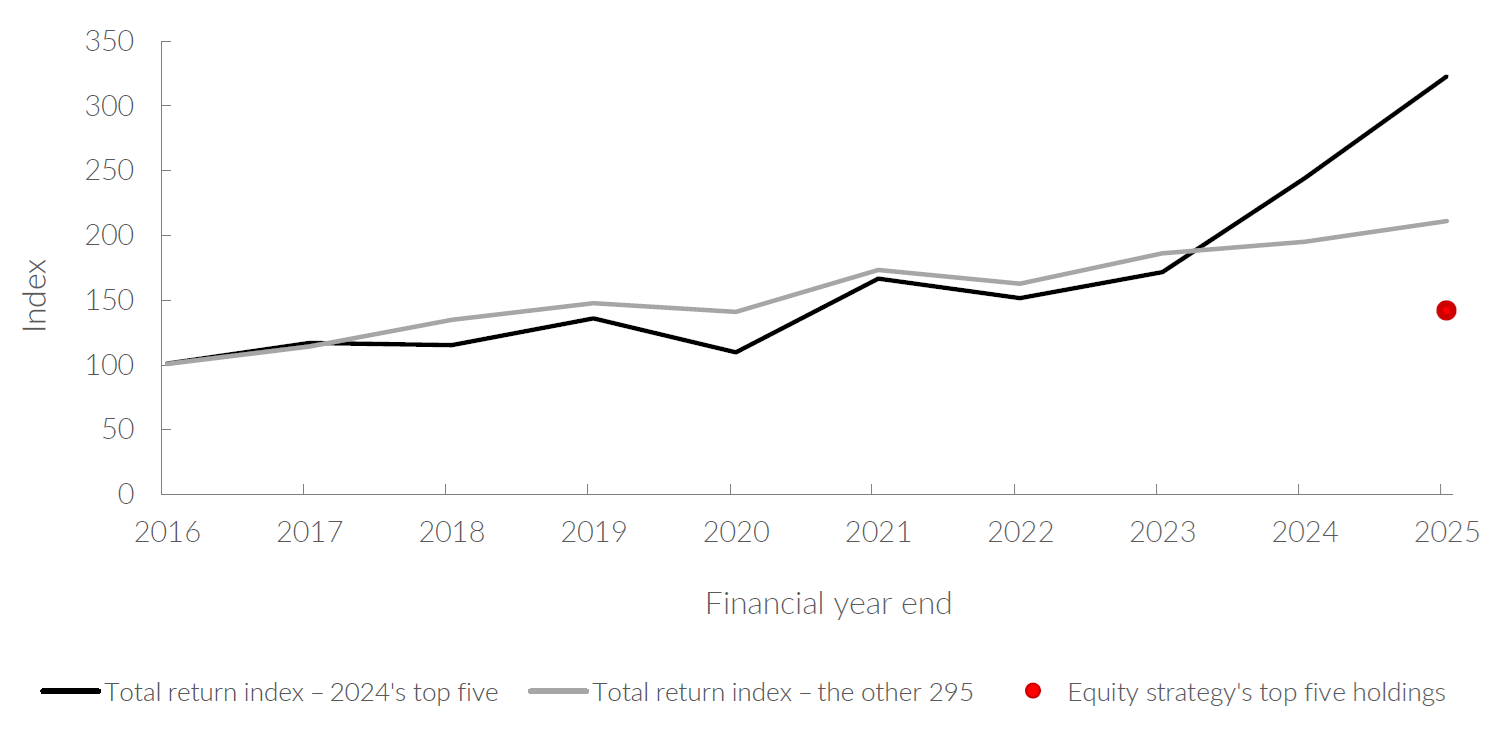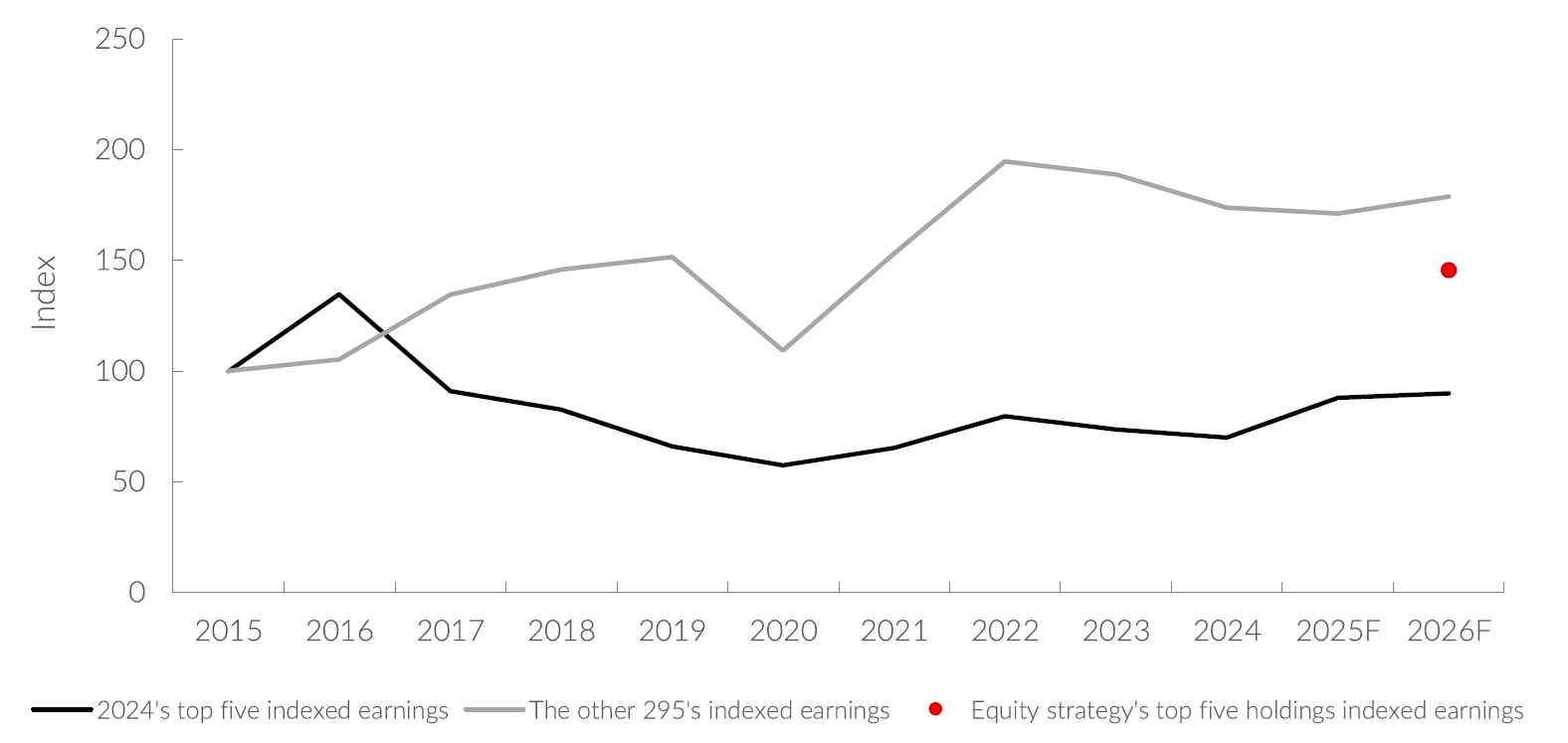Top 5 ASX 300 contributors versus the rest. Something must eventually break
Real (inflation-adjusted) returns from the S&P/ASX 300 Accumulation Index (the Index) have been reasonable of late, perhaps even very good. The composition of those returns, though, has been extraordinary.
Putting market dislocation into perspective
In the past, we’ve used rank correlations to illustrate periods of extreme market dislocations. In this quarterly commentary, we’ve settled for something (hopefully) more relatable. To set the scene, we start by detailing the June 2024 financial year (FY) total returns from the Index, the five biggest contributors to those returns and their weights in the Index.
We then track how those same five companies have performed in the lead up to FY 2024 and how they’ve gone on to perform in FY 2025. We end with trying to make sense of it all. Here goes…
A few companies are doing all the heavy lifting
In FY 2024, the Index returned 11.9%. The top five contributors to this return are shown in Table 1. The five contributors were Commonwealth Bank of Australia (ASX: CBA), Westpac Banking Corporation (ASX: WBC), National Australia Bank Limited (ASX: NAB), Goodman Group (ASX: GMG) and Wesfarmers Limited (ASX: WES). These five companies contributed two-thirds of the Index’s total return and comprised a starting weight of only 19% of the Index.
Table 1 - The top five contributors to the Index returns in FY 2024

Let’s look at the numbers. Focusing on the first row, CBA returned 32.5% in FY 2024 (column A). Its Index weight was 7.7% at the start of FY 2024 (column B), resulting in its weighted contribution being 2.5% (column C = column A x column B). Column D shows the proportion of the overall stock market’s return that each company accounted for, in CBA’s case, 21.1% (2.5% in column C divided by the 11.9% total return from the Index).
In summary, the weighted return of these top five performers was 42.2%, they represented a total of 19.1% of the Index by weight and contributed eight percentage points (67.6%) of the Index’s overall 11.9% return in FY 2024.
Table 2 repeats much of Table 1 but back solves for the returns generated by the other 295 companies in the Index (refer to the boxed area).
Table 2 - The top five contributors vs the other 295 companies

The rest of the market barely moved
If the top five contributors had a combined index weight of 19.1% at the start of FY 2024 (total of column B), then the other 295 had a weight of 80.9%. And if these five companies contributed 67.6% (or a weighted 8% = 67.6% x 11.9%) of the market’s total returns, the remaining 295 only contributed the residual, 32.4% or a weighted 3.9% (32.4% x 11.9%).
By extending this one step further, it implies that the other 295 companies collectively delivered a paltry 4.8% return in FY 2024. This is just the return necessary to make the weighted average return equal to the Index’s 11.9%, specifically (42.2% x 19.1%) + (4.8% x 80.9%) = 11.9%.
To recap, 67.6% of the entire stock market’s returns came from only five companies that comprise less than 20% of the overall market. They returned 42.2% in FY 2024, with the other 295 Index constituents only returning 4.8%. This is punchy, but it is only part of the story.
The other part is tracking how those five companies have performed from 2016 to 2025. The results, shown in Table 3, are staggering.
Table 3 - Weighted returns of the top five stocks and the remaining 295

You’ll notice that the FY 2024 data in Table 3 repeats the data reflected in Tables 1 and 2. For each of the other periods reflected, we’ve shown the returns that the same five companies contributed to the total Index returns and, using their Index weights at the start of the year, back solved the weighted returns of these five companies and the weighted returns of the remaining 295 companies (in exactly the same way as we did for FY 2024).
It is the red-boxed area that is most striking. It shows an index of total returns from these two cohorts. Had you invested $100 in the top five companies (in proportion to their size at the time) on 30 June 2015, it would have grown to $323 by 30 June 2025. $100 invested in the other 295 companies (in proportion to their size at the time) would only have grown to $211. The profile of the returns is shown in Graph 1. The red dot shows the weighted average total return of the Allan Gray Australia Equity strategy’s top five holdings as at 30 June 2025 (similarly indexed to 100 in 2015).
Graph 1 - Index return profiles and the Allan Gray Australia Equity strategy

Source: FactSet, 30 June 2025. The Allan Gray Australia Equity Fund portfolio is generally representative of the Allan Gray Australia Equity strategy portfolio, which includes institutional mandates that use the same strategy.
From FY 2016 to FY 2023, the returns from FY 2024’s top five companies closely approximated the returns from the other 295 Index constituents with years of out- and underperformance. All excess returns from these five companies have come since 30 June 2023 and have exceeded the returns of the other 295 companies by a cumulative 53%. The Allan Gray Australia Equity strategy’s largest holdings have notably more depressed prices than these two cohorts.
Returns are up – but not because of earnings
The next question is whether the underlying fundamentals of these five companies have justified their excess returns. Based on earnings, the answer is an emphatic “NO”. Graph 2 shows the earnings of these two cohorts over time. Earnings from FY 2024’s top five companies have meaningfully lagged that of the rest of the market.
Graph 2 - Indexed earnings of the top five companies, the remaining 295 companies and the Equity strategy

Source: FactSet, Datastream, JP Morgan, 30 June 2025. The Allan Gray Australia Equity Fund portfolio is generally representative of the Allan Gray Australia Equity strategy portfolio, which includes institutional mandates that use the same strategy.
The skew towards the banks, whose earnings are flat-to-down over the past 10 years, explains much of this. Falling bank net interest margins, rising costs, and significant share issuances at depressed prices during COVID-19 have reduced per-share earnings of the banks. Also, Wesfarmers’ demerger of Coles played a part in its earnings decline. The red dot shows the weighted average earnings per share of the Allan Gray Australia Equity strategy’s top five holdings today (similarly indexed to 100 in 2015).
The extent to which five very large companies in Australia have outperformed the aggregate of all others is remarkable. Even more so when one realises that it is not explainable by improvements in their underlying fundamentals. The Allan Gray Australia Equity strategy’s largest holdings’ depressed prices (relative to the Index’s FY 2024 top five) are not explainable by their fundamentals either, where earnings growth has been reasonable notwithstanding consensus’s very bearish oil and aluminium price forecasts which dampen their 2026 forecast earnings.
Price-insensitive flows are creating distortions
What has caused this extreme dislocation? We think the catch-all explanation for this madness is price-insensitive flows.
Readers may think that passive investors are to blame for this. And they’re probably right, at least in part. Passive investing is increasingly replicating a narrower and narrower subset of our market on account of liquidity constraints (liquidity quickly falls as the size of a company shrinks, making these companies poor inclusions in passive indices that attract significant inflows). But we believe there are other likely contributing factors.
One is the degree to which regulators like APRA in Australia are forcing superannuation funds to become more indexaware. The introduction from 1 July 2023 of APRA’s Annual Superannuation Performance Test for Trustee Directed products has draconian outcomes for superannuation funds that underperform their peers. The outcome has almost certainly forcibly sucked capital from actively managed pockets into passive or quasi-passive pockets that have significantly added to the passive firepower. This is because a move to passive naturally involves more buying of the largest capped Index constituents, which tend to be underweight in many active manager portfolios.
Outsize flows into sector-specific indices (e.g. the MSCI World Financials Index) and region-specific indices (e.g. MSCI EAFE Index) have also likely contributed to the dislocation. For example, CBA is almost 12% of our Index today, yet it is approximately 16% of Australia’s allocation in the MSCI EAFEIndex.
Eventually, fundamentals always matter
No matter the reason though, fundamentals have always won out in time. The value of all companies is the present value of the cash flows investors will receive from owning those companies. Earnings are the best proxy for those cash flows. We’d be the first to concede that it is difficult to pinpoint the catalyst for this dislocation reversing. But that has always been true for historical market dislocations. And even when they have reversed, it is hard to identify what tipped over the first domino.
If it isn’t already extremely obvious by now, the Allan Gray Australia Equity strategy doesn’t currently own any of these five companies. With a dislocation this severe, something must eventually break. We relish the moment that the bottom falls out of this bucket and when fundamentals matter again. Until then, thank you for your patience.
The above wire is an extract from Allan Gray Australia’s June 2025 Quarterly Commentary, which you can read in full here.
Learn more
Contrarian investing is not for everyone, however, there can be rewards for the patient investor who embraces Allan Gray’s approach. Visit the Allan Gray Australia Equity Fund profiles to find out more.


5 stocks mentioned
2 funds mentioned

